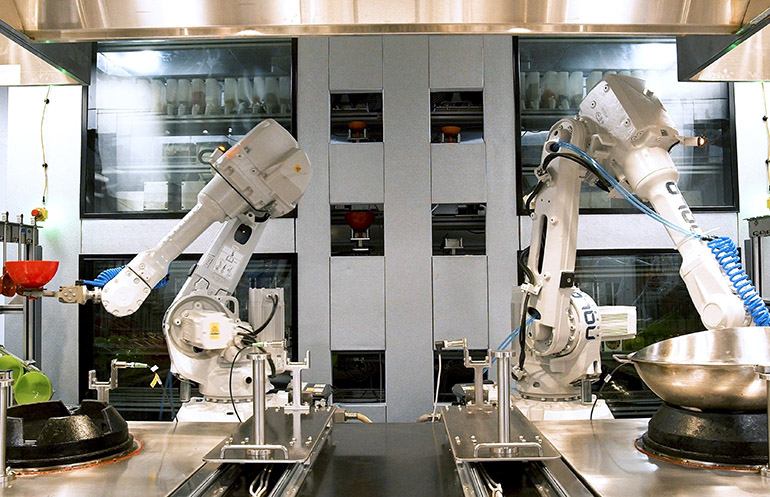|
Listen to this article  |

Nala provides automation for food bowls and other meals. Source: Nala Robotics
Since the public debut of generative artificial intelligence and large language models in late 2022, robotics developers have been working to take advantage of the latest AI capabilities. Nala Robotics Inc. said that ChatGPT enables its autonomous chefs to prepare almost any recipe.
Generative AI and robots can help restaurants and commercial kitchens save money, as well as address labor turnover and shortages, according to Ajay Sunkara, founder and CEO of Nala Robotics.
“I started the company six years ago, and our automation of commercial kitchens went through different phases of development during the pandemic,” Sunkara told The Robot Report. “Nala started with the intention of making food consistently, but hygiene and labor shortages changed our priorities. Then there was the emergence of generative AI.”
 Learn from Agility Robotics, Amazon, Disney, Teradyne and many more.
Learn from Agility Robotics, Amazon, Disney, Teradyne and many more.
Nala Robotics pivots post-pandemic
“We built our system to address the issues the industry is facing, as well as the technology innovations emerging our path today,” added Sunkara. “Nala runs one of the only robotic commercial kitchens in the U.S. in Naperville, Ill. It has been operating for more than 25 months.”
The Chicago-based company sells The Wingman robotic fryer, the Nala Chef automated kitchen, and the Spotless robot for loading and unloading dishwashers. It also provides systems that can assemble sandwiches, food bowls, and pizzas.
“We’ve pivoted in the past few years when we learned of the need for end-to-end solutions,” Sunkara noted. “Most previous innovations in food robotics can handle one task or area, but with hygiene concerns during the COVID-19 pandemic, the industry needed machines to handle everything from ingredients to delivery.”
“The second aspect or priority we had to change was the cost impact,” he added. “When inflation was low before the pandemic, robotics was a distant arena for traditional commercial restaurants. Now, any small or midsize business can afford to look at robotics because of wage growth. In California, the minimum wage is $20, which made robotics a more affordable alternative to help ease pressure on restaurant owners.”
While the majority of Nala Robotics’ customers are larger chains, adding robotics is more involved for them because of the need to customize systems to their processes. The company is working on pilots with bother larger and smaller customers, said Sunkara.
AI addresses need for kitchen skills
A new employee or a robot now requires about the same amount of time to learn a range of ingredients and how to do things such as build a sandwich and add condiments, asserted Sunkara.
“A large chain has more throughput than a [delivery-only] cloud kitchen, but robots can help, whether it’s 20 units or less,” he said. “We’ve experimented with machine learning for a long time and have data showing significant results with our models.”
Sunkara said that a key application for AI is in building new recipes.
“For example, fusion restaurants such as our kitchen can tell ChatGPT the ingredients we have for a given day — tomatoes, pumpkins, etc.,” he said. “The AI can come back with a potential recipe. That’s an area where humans have not gone before.”
Optimizing ingredient use can help reduce food waste, said Sunkara. What’s the best mix of automation and human oversight?
“It depends on the application,” he replied. “The majority of preparation of cut vegetables and frozen food has been automated for some time now, but not everything is cost-effective for a commercial kitchen or a small restaurant to automate. We have to be strategic about where we apply automation for cost savings.”
“It’s a matter of paying a worker for eight hours versus a robot for 24 hours, but there’s the utilization rate and payback time,” Sunkara said. “We differ from our competition in our approach to maintenance, and most of our systems are built for end-to-end use.”
“For example, our frying system can not only put fries or wings in oil and take them out it can adjust the count of wings or weight, measure the temperature of the oil, sauce the wings, and clean the utensils and packaging,” he claimed. “This is where you’ll see a significant impact — you need to save a full labor hour, not a half or one-quarter hour of labor.”
Nala Robotics is one of the first food technology companies to integrate with AI for such multi-tasking, said Sunkara. It offers its systems through direct sales, rental, lease, and a robotics-as-a-service (RaaS) model. In RaaS, a customer uses Nala’s infrastructure and pays by the dish.
Automating the future of work and home tasks
Nala Robotics is also actively exploring generative AI for human-machine interaction (HMI) and for robots to self-correct and improve efficiency on their own, said Sunkara.
“There is a danger of overexuberance in AI,” he acknowledged. “The past few years have seen a lot of machine learning development, and AI is an extension of those models. But it’s more like the software industry, where the dot-com era went really fast, and the market wasn’t ready to absorb those changes.”
“With robotics, the whole industry has to work together to be accepted,” Sunkara added. “Automation helped as people got more accustomed to remote work during the pandemic, and they’re now ready for AI.”
While relatively little money is currently being invested into household robotics, Sunkara said he believes that the potential market is “huge” if they could do everyday tasks.
“First, our goal is to get into commercial environments, where it was hard to show restaurant owners the potential of robots,” said Sunkara. “Whatever experience we’re gaining can eventually be utilized in at-home tasks.”
Credit: Source link


Comments are closed.